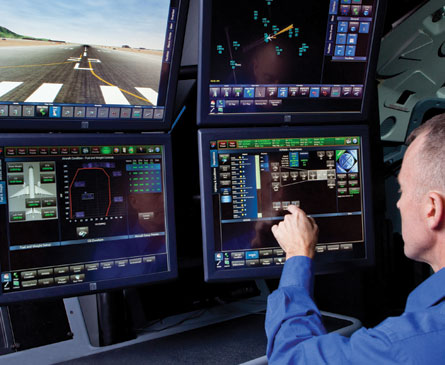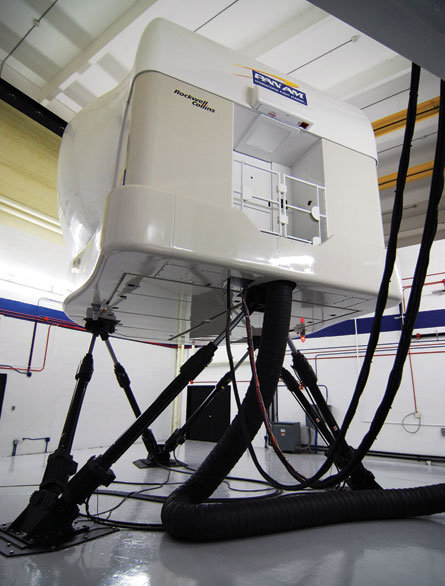When it comes to civil flight simulation, CAE and Thales are the names that usually spring to mind. These two have captured most of the market - but other, newer players are making their presence known.
One is Montreal-based Mechtronix, which has gained a foothold in the civil simulation market with its highly capable and low-cost FFS X series of full-motion devices.
Rockwell Collins is seeking to reintroduce itself to the market with products based on its Core simulation architecture. Intended for the civil and military sectors, Core uses advanced technologies, off-the-shelf components and a modular design to increase training effectiveness and customer value, says Collins.
It touts the Core architecture as highly configurable with an open-system format allowing upgrades and incorporation of new technologies. Core has been used to develop and certificate Collins' Edge Boeing Next Generation 737 full-flight simulator. Two of these Level D devices are in use - one at CTC Aviation's Southampton, UK facility, the other at the Pan Am International Flight Academy in Miami.
Flight International was invited to Miami to see if the Core-developed simulator had an edge over its more established competitors.
The academy dates back to Pan Am International Airways. Training has been conducted at the Miami site since the early 1980s. The Edge 737 simulator has been in use since June 2010, when it received Federal Aviation Administration Level D certification. The simulator earned UK Civil Aviation Authority Level D certification in November 2009.
Pan Am has been leasing the simulator from Rockwell Collins in a co-operative venture. Each day, it is used for five 4h training sessions, with the remaining period reserved for routine maintenance. During high-demand periods, the simulator's reliability has allowed the academy to cut maintenance downtime to 2h a day, freeing another 2h for training.
The simulator was sited conventionally in an air-conditioned bay, but, unusually, it was orientated diagonally because of space constraints. The simulator has two major components - the basic simulation unit and the aircraft-specific module. The module, or flightdeck, is in the cab, while the unit comprises everything else. The cab sits atop Moog electrical actuators, seemingly the industry standard. They are more reliable and environmentally friendly than hydraulic actuators, drawing less than 30% of the latter's electrical load. The cab has a 3m (10ft) diameter mirror ball (dome) for display projection.
 |
|---|
©Rockwell CollinsRockwell Collins used its Core open-system architecture to develop the Edge Boeing 737NG full-flight simulator |
Unusually, there is a lack of external walkways on top of the cab, with all equipment serviceable from inside. Three external equipment racks house the power supply, PC-based computers and networking switchgear. The entire simulator system is run over an Ethernet databus, with the limited amount of cabling evident in the compact "waterfall" of wires connected to the cab.
Basic simulation units are located on the left-hand side of the cab's aft area, with the flightdeck and items on the right-hand side of the aft area making up the aircraft-specific module. The instructor operator station is the primary basic simulation unit in the cab. Mounted on a pole, which can be moved to suit customer specifications, the instructor operator station has a worktable, keyboard and four 17in (43cm) LCD monitors.
Real aircraft parts
On this occasion, the flightdeck was configured as a 737-800, accurately modelled to include the several large circuit-breaker panels behind the pilot seats. Collins uses real aircraft parts for the flightdeck, unlike some low-cost producers. Aircraft equipment may cost more than bespoke kit, but Collins felt long-term supportability and reliability would be better served by using the real thing.
Before our flight, I familiarised myself with the instructor operator station. The Edge simulator's controls were intuitive to operate and allowed for rapid changing of conditions and repositioning of the aircraft. The station is highly customisable, letting each instructor arrange displays for optimal training. The instructor operator station's interface language can be changed with several keystrokes.
Collins has orders for five machines from Chinese operators, who will doubtless appreciate the machine's multilingual capability.
The engines were started from the instructor operator station position, inertial navigation systems aligned, and the aircraft was positioned on Miami International airport's Runway 08R for take-off. Before releasing the brakes, I entered a route into the flight management system.
With the engines spooled up, I released the brakes and manually set take-off thrust. During the ground run, I could feel the expansion joints in the runway as we accelerated for lift-off. As much as any simulator does, the Edge felt like the real thing as we lifted off into the daylight visual scene. The ground scene was fairly detailed as we flew round the Miami area, allowing easy identification of such locations as South Beach and Key Biscayne.
Sightseeing complete, I visually manoeuvred the aircraft for an instrument landing system approach in visual meteorological conditions to Runway 08R. The winds were calm, and I had no difficulty tracking the localiser inbound. Before glideslope intercept, I configured the aircraft for a flaps 30 landing, with a target indicated air speed of 135kt (250km/h). The simulator's eight-speaker sound system provided valuable cues that helped me keep the 737 on speed during the approach. Using mainly visual references, I was able to execute the approach, and flare at the right height for a smooth touchdown. As on take-off, during landing I could feel the runway texture as we slowed to a stop.
The lighting conditions were set for night-time conditions, and the aircraft was repositioned for take-off on Runway 08R. With the engines spooled up, I released the brakes and set take-off thrust. Accelerating through about 40kt, I heard a loud bang and felt the aircraft yaw to the left. The instructor had caught me unaware. Only by retarding both throttles to "idle" while applying brakes was I able to keep the aircraft on the runway surface. For a brief period during the low-speed engine failure exercise, I was caught up in the moment, reminding me that real lessons can be learned in a simulated environment.
After resetting the simulator and clearing the engine failure, I again advanced the power for take-off from Runway 08R. Once airborne passing 160kt, the left engine again failed as we flew into a 400ft (120m) overcast ceiling. While responding to visual cues and the primary flight display's slip indicator, I found the simulator's motion system helped me correctly diagnose the engine failure. I used the multifunction display's map to set the 737 up on an ILS final. I hand-flew the single-engine approach, and with 0.8km (0.4nm) of visibility (RVR2400), easily picked up the simulated runway environment for a full stop landing.
Winter setting
To get a more complete view of the EP-1000 visual system, the simulator was then repositioned to London's Gatwick airport so I could experience a daylight winter setting. Three liquid-crystal-on-silicon projectors provide a 200° x 40° field of view, enough to conduct visual operations. A visual circuit was flown at Gatwick, with a 30kt crosswind chosen to show what blowing snow looked like.
 |
|---|
©Rockwell CollinsMiami-based Pan Am leases an Edge |
I found the weather depiction realistic, but more variation in the individual visual scene elements would have added to it.
I have flown a good number of different Level D simulators, and can, with some assurance, say that the most realistic visual display system I have seen is CAE's Tropos-6000. The Edge's visual system is clearly more than adequate for conducting simulated flight training, as befits its Level D certification, but not quite as sharp as that of the Tropos-6000.
Collins does offer a more capable image-generation system, the EP-8000.
During my 1h flight in the Edge 737-800 simulator, I gained an appreciation for its high level of fidelity. I found the visual system - the same one used in the Boeing 787 simulator I flew last year - provided a good field of view and enough texture to make the experience seem real enough to conduct training. The electric motion system was remarkable for its quiet and lurch-free motion.
Pan Am International Flight Academy's experience with the Edge simulator has shown it to be a robust training tool, with almost 100% reliability. The simulator's modular nature should enable Collins to combine its basic simulation unit with a customer-developed aircraft specific module to provide a realistic, highly reliable training tool. The Edge simulation suite is capable of hosting aircraft as large as a 787 and, given its inherent flexibility, may help make Rockwell Collins a more familiar name in the civil simulation market.
Source: Flight International
















